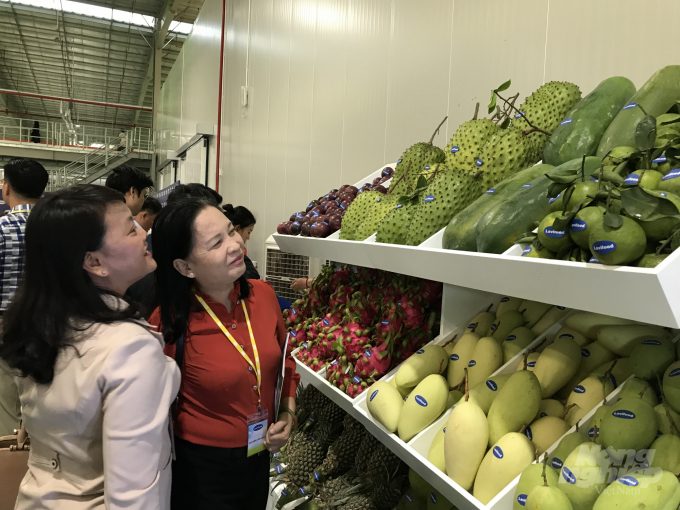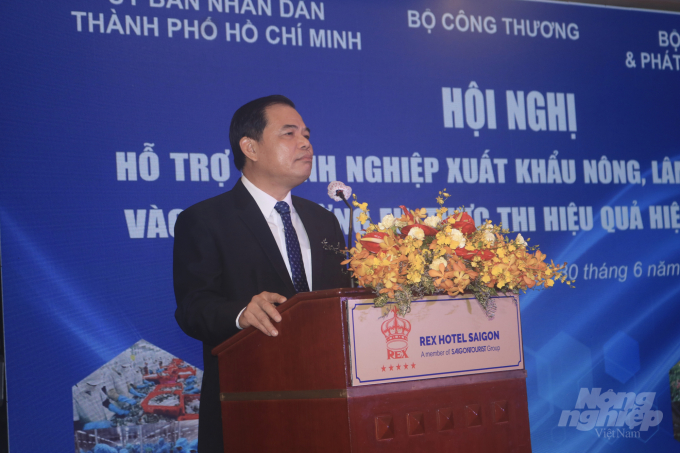
EVFTA is opening up great opportunities for Vietnam to boost exports of agricultural products to the EU. What to do to effectively take advantage of this opportunity?
Mechanical Assembly is very large
Table of Contents
At the conference “Supporting businesses to take advantage of opportunities to develop exports of agricultural, forestry and fishery products to the EU, to effectively implement the EVFTA Agreement”, held in Ho Chi Minh City on June 30, Minister of Industry and Trade Tran Tuan Anh, said that the EU is the 2nd largest import market in the world, accounting for 14.9% of total global imports.
Despite being the second largest export market of our country, Vietnam only accounts for about 2% of the total EU import. Therefore, we have opportunities for export growth, especially for agricultural, forestry and aquatic products.

Vietnamese vegetables and fruits have many opportunities to boost exports to the EU. Photo: Thanh Son.
After EVFTA takes effect, Vietnam’s agriculture, forestry and fishery products will be able to access a potential market with a population of over 500 million people and a GDP of US $ 15,000 billion.
Imports of agricultural commodities currently account for about 8.4% of total EU imports. Therefore, Vietnam still has room to grow exports of agricultural, forestry and aquatic products to serve the huge consumption demand of this market.
The EVFTA agreement has the highest level of commitment that a partner for Vietnam out of all FTAs has been signed (99% of import tariff lines between the two sides were abolished within 7-10 years), especially for Some agricultural products that we have strengths in manufacturing and exporting such as rice, seafood, coffee, vegetables …
The signing and implementation of the EVFTA Agreement not only provides opportunities for export growth but also helps our country’s Agriculture sector to accelerate restructuring towards focusing on improving competitiveness through quality. product quality, traceability, packaging, etc., contributing to bringing Vietnam’s agricultural, forestry and fishery goods more deeply into global supply chains.
According to the Minister of Agriculture and Rural Development Nguyen Xuan Cuong, with the advantages of natural conditions, production and business capacity, the Agriculture sector of Vietnam can take advantage of many opportunities from the EVFTA Agreement, creating an important foundation. for sustainable development of the country in the process of deeper and deeper international integration.
EVFTA will really be a golden opportunity, creating a big push for exports of agricultural, forestry and fishery products, especially with products with strong and competitive advantages such as seafood, vegetables, rice, cashew, coffee, pepper, wooden products …
Mr. Tran Thanh Hai, Deputy Director of the Import-Export Department (Ministry of Industry and Trade), said that for a long time, many agricultural, forestry and fishery products of Vietnam, though subject to import tax, have penetrated very strongly. into the EU. Therefore, when EVFTA takes effect, with the immediate removal of 85.6% of tariff lines (for general goods imported from Vietnam), the chances of promoting agricultural, forestry and fishery exports to the EU are even greater. again.
For example, coffee exports to the EU are subject to 7.5-11.5% tax, but reached $ 1.09 billion in 2019 (accounting for 37.9% of the value of Vietnam’s coffee exports). Immediately after EVFTA takes effect, import taxes on coffee from Vietnam and the EU will be completely eliminated. This is a great opportunity for Vietnam to increase its competitiveness and promote coffee exports to this very important market.
Or the fishery sector, currently the majority of import tax rates to the EU base from 6-22%. After EVFTA takes effect, 50% of tariff lines will be removed immediately, the remaining 50% of tariff lines will be removed after 3-7 years … These are favorable conditions for Vietnam to boost seafood exports to Vietnam. EU, which accounts for 11.3% of total seafood export value of our country …
For rice, in 2019, Vietnam can only export to the EU with a modest value of 10.7 million USD, because the EU’s tax rate on rice imported from Vietnam is quite high: absolute tax of 175 EUR / ton with milled rice, 65 EUR / ton with broken rice, 211 EUR / ton with rice.
Under the EVFTA’s commitment, the EU will give Vietnam a quota of 80,000 tons of rice (0% tax) on milled rice and fragrant rice, and eliminate tax on broken rice in 5 years. This is an opportunity to boost rice exports to the EU in the near future, because this region is consuming about 2.5 million tons of rice per year.
Mr. Pham Thai Binh, General Director of Trung An High-tech Agriculture Joint Stock Company, said that 80,000 tons of rice is not large, but it is very important because rice exported to the EU often has a high price, and getting into the EU will be an opportunity to improve the reputation of Vietnamese rice in the world market.
Action of MARD
However, according to the leaders of the Ministry of Industry and Trade, the Ministry of Agriculture and Rural Development and many delegates attending the conference, the challenges for agriculture, forestry and fishery exports to the EU will also be very big, because when removing the Import tariff lines, technical barriers of EU are inherently tight, more likely to be stricter.

Minister Nguyen Xuan Cuong spoke at the Conference. Photo: Thanh Son.
Minister of Industry and Trade Tran Tuan Anh said that the EU is still a market with very high technical barriers, especially regarding animal and plant quarantine; quality control, food safety and hygiene; combating illegal, undeclared and unregulated fishing (IUU); declaration of legal timber origin … Therefore, the implementation of the EVFTA Agreement, for Vietnamese enterprises is still a continuation in the process of complying with these requirements from the EU.
In this situation, in order to take advantage of opportunities of the EU market in order to effectively implement the EVFTA Agreement, according to the Minister of Agriculture and Rural Development Nguyen Xuan Cuong, the Ministry will issue a separate implementation plan. First of all, focus on promoting propaganda, guiding agricultural businesses to better understand the incentives and advantages of each agricultural, forestry and fishery product line.
Enhancing the dissemination of technical regulations, technical barriers in EU, agriculture, forestry and fishery trade to guide people, businesses and localities to timely capture and adjust production and business meet the needs of the market.
Organize production, improve product quality in accordance with international regulations; develop and harmonize standards and regulations that meet EU technical requirements.
Strongly develop the code of planting areas, geographical indications, ensure traceability, quality and food safety, apply plant and animal quarantine (SPS) measures in accordance with EU regulations. Focus on removing the IUU yellow card for Vietnamese seafood. Quickly implement VPA / FLEG Agreement to promote the export of sustainable timber and wood products.
Attract and promote exporters, increase investment in deep processing to increase added value, take advantage of incentives from EVFTA, especially for processed agricultural, forestry and fishery products.
Strengthening the capacity of farmer organizations, thereby strengthening the competitiveness of the domestic market for meat and dairy products; livelihood support for smallholders.
Develop a strategy to develop export markets for agriculture, forestry and fisheries into the EU, as well as a strategy to attract FDI from the EU into Vietnam’s agriculture, to link Vietnam’s agriculture to the global value chain.
According to the Minister of Agriculture and Rural Development Nguyen Xuan Cuong, the opportunity to boost exports of agricultural products to the EU is huge but challenges are many. However, the harsh conditions are also a positive pressure to change the standards, regulations, practices of the Ministry of Agriculture and Rural Development to localities, businesses and farmers.
For a long time, the majority of agricultural products exported to the EU are subject to taxes, but we still “win” when exporting with great value to this market. From August 1 of this year, when EVFTA comes into effect, most of the tax lines will be eliminated. It is possible that the highest efficiency will be achieved in exporting agricultural, forestry and fishery products to the EU.
